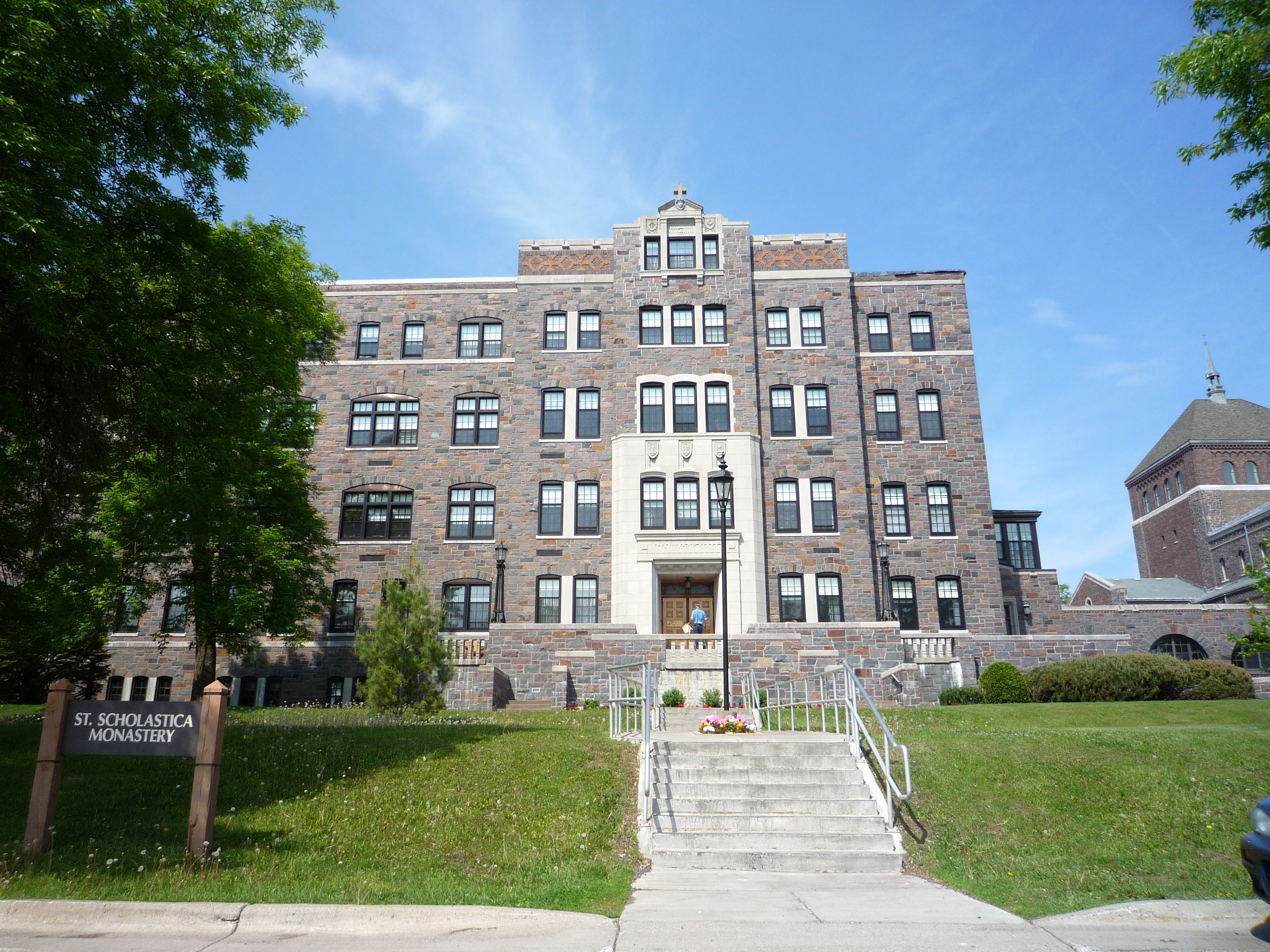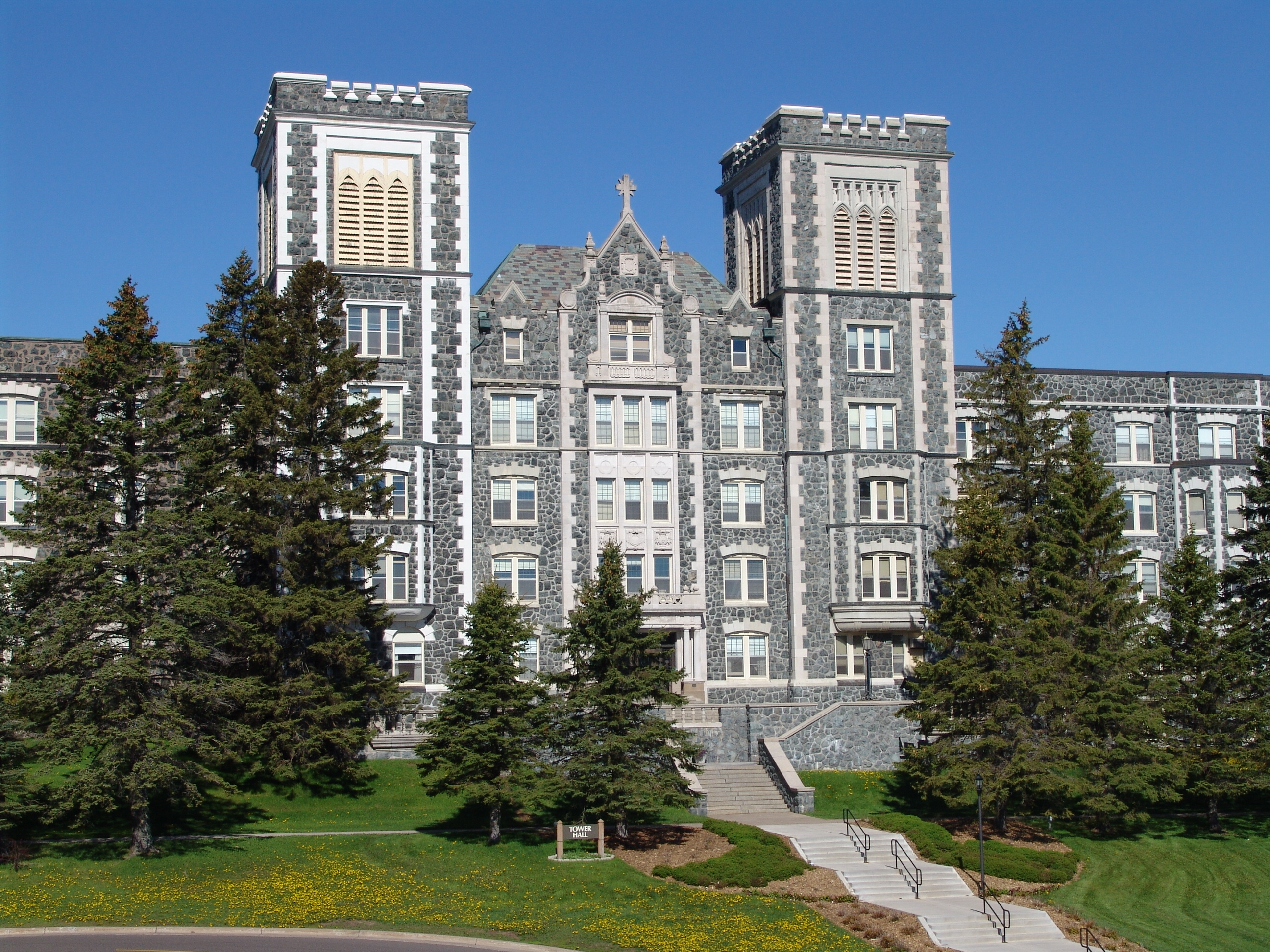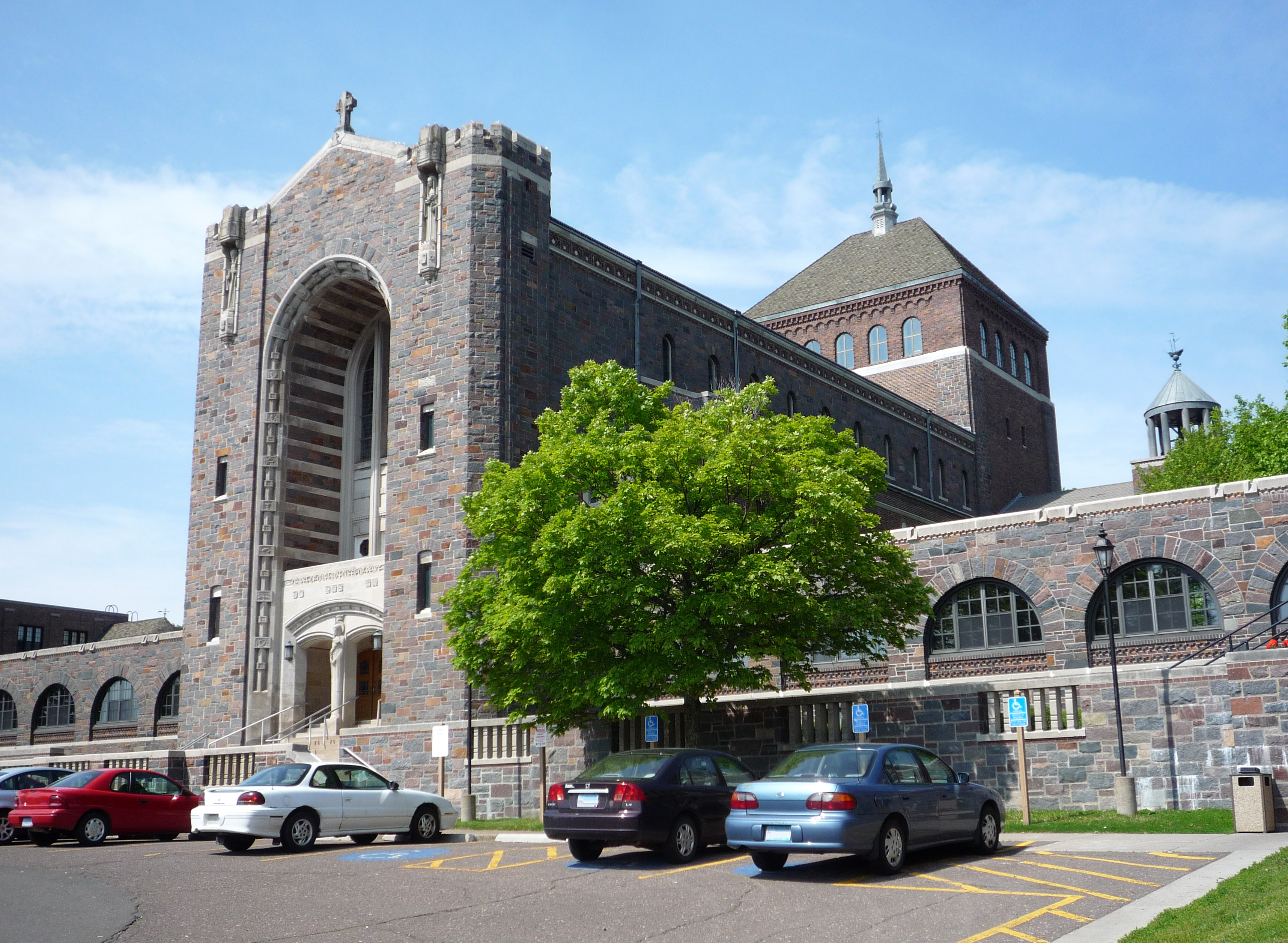The College of St. Scholastica on:
[Wikipedia]
[Google]
[Amazon]
The College of St. Scholastica (CSS) is a private
 The College of St. Scholastica owes its existence to the combining of two forces: Benedictine missionaries and the settlement of Duluth. In 1892, Mother Scholastica Kerst and 28 sisters arrived from St. Joseph, Minnesota, to spearhead the establishment of a Benedictine
The College of St. Scholastica owes its existence to the combining of two forces: Benedictine missionaries and the settlement of Duluth. In 1892, Mother Scholastica Kerst and 28 sisters arrived from St. Joseph, Minnesota, to spearhead the establishment of a Benedictine
 Tower Hall is St. Scholastica's castle-like central building. Its origins date to a picnic in around 1907, when the Diocese of Duluth's Bishop
Tower Hall is St. Scholastica's castle-like central building. Its origins date to a picnic in around 1907, when the Diocese of Duluth's Bishop

Official athletics website
{{DEFAULTSORT:Saint Scholastica, College Of, The Benedictine colleges and universities Education in Duluth, Minnesota Educational institutions established in 1912 Former women's universities and colleges in the United States Universities and colleges in St. Louis County, Minnesota Catholic universities and colleges in Minnesota Association of Catholic Colleges and Universities Roman Catholic Diocese of Duluth 1912 establishments in Minnesota
Benedictine
, image = Medalla San Benito.PNG
, caption = Design on the obverse side of the Saint Benedict Medal
, abbreviation = OSB
, formation =
, motto = (English: 'Pray and Work')
, foun ...
college in Duluth, Minnesota
, settlement_type = City
, nicknames = Twin Ports (with Superior), Zenith City
, motto =
, image_skyline =
, image_caption = Clockwise from top: urban Duluth skyline; Minnesota ...
. Founded in 1912 by a group of pioneering Benedictine Sisters, today St. Scholastica educates almost 4,000 students annually and has graduated more than 29,000 alumni. The college offers a liberal arts education and is located on 186 wooded acres overlooking Lake Superior
Lake Superior in central North America is the largest freshwater lake in the world by surface areaThe Caspian Sea is the largest lake, but is saline, not freshwater. and the third-largest by volume, holding 10% of the world's surface fresh wa ...
.
History
 The College of St. Scholastica owes its existence to the combining of two forces: Benedictine missionaries and the settlement of Duluth. In 1892, Mother Scholastica Kerst and 28 sisters arrived from St. Joseph, Minnesota, to spearhead the establishment of a Benedictine
The College of St. Scholastica owes its existence to the combining of two forces: Benedictine missionaries and the settlement of Duluth. In 1892, Mother Scholastica Kerst and 28 sisters arrived from St. Joseph, Minnesota, to spearhead the establishment of a Benedictine motherhouse
A motherhouse is the principal house or community for a religious institute
A religious institute is a type of institute of consecrated life in the Catholic Church whose members take religious vows and lead a life in community with fellow memb ...
and an academy in Duluth.
The school and convent were located at Munger Terrace before growth required a move to a new facility at Third Avenue East and Third Street. Named Sacred Heart Institute, the high school continued to grow rapidly. Duluth's rapid expansion led to a third move in 1909 to its present location.
Mother Scholastica's vision for the college can be summed up in this quote attributed to her: "My dream is that someday there will rise upon these grounds fine buildings like the great Benedictine abbeys. They will be built of stone: within their walls higher education will flourish."
The school expanded its course offerings in 1912 to include a junior college and changed its name to The College of St. Scholastica. The college started with only six students and 52 courses offered in eight departments in its first year. Academic leadership and research were stressed early as an integral part of the college's commitment to Benedictine values.
In 1924, the college became a four-year liberal arts institute with an enrollment of 68. The school's first baccalaureate degrees were granted in 1926. In 1969, it became a fully coeducational institution.
As a Benedictine institution, the college is affiliated with the Order of Saint Benedict
, image = Medalla San Benito.PNG
, caption = Design on the obverse side of the Saint Benedict Medal
, abbreviation = OSB
, formation =
, motto = (English: 'Pray and Work')
, foun ...
. Its endowment stands at more than $89.9 million.
Presidents
*Mother Agnes Somers, 1924–1942 *Mother Athanasius Braegeleman, 1942–1954 *Mother Martina Hughes, 1954–1958 *Sister Joselyn Baldeschweiler, 1958–1960 *Sister Ann Edward Scanlon, 1960–1967 *Sister Mary Richard Boo, 1967–1971 *The Rev. F. X. Shea, 1971–1974 *Sister Joan Braun, 1974–1975 *Bruce Stender, 1975–1981 *Daniel Pilon, 1981–1998 *Larry Goodwin, 1998–2016 *Dr. Colette McCarrick Geary, 2016–2019 *Dr. Barbara McDonald, 2019–presentSymbols
The shield of the college shows a lily, blooming with three flowers symbolizing the three Persons of the Blessed Trinity. The base of the lily is enclosed by a crescent, the heraldic symbol of the Virgin Mary, and the purity of Christian teaching. Symbolizing the college, a book occupies the center of the field, bearing the motto of St. Scholastica. It is adapted from the second part of the Book of Proverbs line "Her ways are ways of beauty, and all her paths are peace," and reads in Latin, "."Campuses
In addition to the main campus in Duluth, St. Scholastica has sites in St. Cloud,St. Paul
Paul; grc, Παῦλος, translit=Paulos; cop, ⲡⲁⲩⲗⲟⲥ; hbo, פאולוס השליח (previously called Saul of Tarsus;; ar, بولس الطرسوسي; grc, Σαῦλος Ταρσεύς, Saũlos Tarseús; tr, Tarsuslu Pavlus; ...
and embedded sites in Brainerd, Austin, Cloquet, Inver Grove Heights
Inver Grove Heights is a city in Dakota County, Minnesota, United States. The population was 35,801 at the 2020 census. The city was formed on March 9, 1965, with the merger of the village of Inver Grove and Inver Grove Township.
It is one of 1 ...
, Rochester
Rochester may refer to:
Places Australia
* Rochester, Victoria
Canada
* Rochester, Alberta
United Kingdom
*Rochester, Kent
** City of Rochester-upon-Medway (1982–1998), district council area
** History of Rochester, Kent
** HM Prison ...
and a virtual campus.
The Duluth campus is home to most undergraduate students. The 186-acre campus is set on a hill overlooking Lake Superior
Lake Superior in central North America is the largest freshwater lake in the world by surface areaThe Caspian Sea is the largest lake, but is saline, not freshwater. and the third-largest by volume, holding 10% of the world's surface fresh wa ...
. Campus buildings include: Tower Hall, the Science Center, Our Lady Queen of Peace Chapel, Burns Wellness Commons, the 500-seat Mitchell Auditorium, the College Library, the St. Scholastica Theatre, Somers Residence Hall, and nine apartment complexes. A new Health Science Center housing graduate health science programs opened for classes in 2016. The building is at 940 Woodland Ave. in the BlueStone development, about a mile from the main campus.
Library
The college library provides over 350,000 print and electronic books, full-text journal databases, interlibrary loan services, laptops, wireless Internet access, group study rooms, and quiet study space. It is located on the upper floors of the Romanesque-styled Our Lady Queen of Peace Chapel building. Along with the library, the college archives preserves the written and visual history of the college, as well as housing special collections such as the papers of James Franklin Lewis.Tower Hall
James McGolrick
James McGolrick (May 1, 1841 – January 23, 1918) was an Irish-born American prelate of the Catholic Church. He was the first bishop of the Diocese of Duluth in Minnesota, serving from 1889 until his death.
Biography Early life
James McGolr ...
commented that the top of the hill at the college's current site was a perfect location for a building. According to the historic records of Sister Agnes Somers, McGolrick and a group of students and sisters climbed to the top of the hill and placed a pile of stones, symbolizing the cornerstone of what would eventually become Tower Hall. In 1906, architects Anton Werner Lignell and Frederick German were hired to draw the plans for the school, Villa Sancta Scholastica Academy, and the motherhouse. Mother Scholastica Kerst disapproved of the plans due to potential defects in the building's design, and the two architects were fired from the project in 1908; it was taken over by Franklin Ellerbe. The following year saw the groundbreaking and start of construction for Tower Hall. Its first unit was completed in 1909. That September, 75 students from the Institute of the Sacred Heart were relocated to what was then called Villa St. Scholastica. Tower Hall was completed in 1928, and had two towers, a north to south axis of 375 feet, turrets at each end, recessed fenestration, and Tudor towers flanking the façade.
Sharing the campus are St. Scholastica Monastery, home of the Benedictine Sisters; and the Benedictine Health Center and Westwood Assisted Living Facility, which provide experiences for many of the college's health science and behavioral arts and sciences students.
In September 2012, the college's Centennial year, St. Scholastica opened a 40,000 square-foot addition to its existing 125,000 square-foot Science Center. The addition includes seven laboratories for chemistry and biochemistry, six faculty-undergraduate student research areas, two classrooms for pre-laboratory meetings and general class use, faculty offices, an atrium-style gathering area, a greenhouse, and state-of-the-art environmental and sustainable technologies throughout, including for storage of chemicals and treatment of hazardous waste.
Academics
The college awards bachelor's,master's degree
A master's degree (from Latin ) is an academic degree awarded by universities or colleges upon completion of a course of study demonstrating mastery or a high-order overview of a specific field of study or area of professional practice.
s, and doctoral degree
A doctorate (from Latin ''docere'', "to teach"), doctor's degree (from Latin ''doctor'', "teacher"), or doctoral degree is an academic degree awarded by universities and some other educational institutions, derived from the ancient formalism ''l ...
s, and has a student to faculty ratio of 14:1. Undergraduate majors include liberal arts and science programs as well as pre-professional programs. Graduate degrees are offered in health professions, education, technology, business, and social work.
All first-year students take part in a program called Dignitas (Dignity). The program's goals are that participants will accept and value the challenges and responsibilities involved in being a first-year college student, reflect on issues from various perspectives, and make connections with the larger community. A combination of course material, co-curricular activities, and common experiences is intended to prepare students for learning both during and after college.
Student life

Campus housing
St. Scholastica houses students living on campus in nine buildings. They are: * Cedar Hall Apartments – Opened in 2003. 100 residents. Total square footage /unit. * Kerst Hall – Opened in 2005. 160 students. Total square footage /unit. * Pine, Maple, Willow and Birch Apartments – Nearly identical. Built in 1973, 1989, 1989, and 1990 respectively. 43 residents each. Total square footage /unit. * Scanlon Hall – Opened in 2005. 128 residents. Total square footage /unit. * Somers Hall – Built in 1964. Primarily first-year housing. Population 314 students. Building also houses the Greenview Dining Room, Somers Main Lounge, Office of Residential Life, Health Services, Campus Operator, and a penthouse lounge/study area. Dorms measure 9'3" x 17'4" (double room) and 6'5" x 17'4" (single-room). * Somers Suites – Built in 1993. Connected to Somers Hall. Four floors. Suites have a square footage of . (2 bedroom) or . (three-bedroom).Student Government Association
The College of St. Scholastica Student Government Association (SGA) is responsible for making decisions and advocating for policy that impacts the student body. The SGA has 40 seats, which include 10 each from the freshman, sophomore, junior and senior classes; as well as representative positions for two graduate students, and two transfer or previously studying-abroad students. SGA officers include the President, Executive Vice President, Financial Vice President, Vice President of Diversity and Inclusion, Chief of Staff, Speaker of the Senate, and Communications Director. The Senate also has three standing committees, which include the Internal Affairs Committee, External Affairs Committee, and Student Affairs Committee. Each standing committee has a chair.Athletics
The College of St. Scholastica fields 22 athletic teams, including 11 women's (basketball, cross country, Nordic skiing, soccer, softball, indoor track & field, outdoor track & field, hockey, tennis, golf, and volleyball) and 11 men's teams (basketball, cross country, Nordic skiing, soccer, baseball, indoor track & field, outdoor track & field, hockey, football, golf, and tennis). The college's athletic teams are called the Saints. All teams, except Nordic skiing, compete in theMinnesota Intercollegiate Athletic Conference
The Minnesota Intercollegiate Athletic Conference (MIAC) is a college athletic conference which competes in NCAA Division III. All 13 of the member schools are located in Minnesota and are private institutions, with only two being non-sectarian.
...
, which is part of the NCAA
The National Collegiate Athletic Association (NCAA) is a nonprofit organization that regulates student athletics among about 1,100 schools in the United States, Canada, and Puerto Rico. It also organizes the athletic programs of colleges an ...
's Division III
In sport, the Third Division, also called Division 3, Division Three, or Division III, is often the third-highest division of a league, and will often have promotion and relegation with divisions above and below.
Association football
*Belgian Thir ...
.
Notable people
*Mary Odile Cahoon
Mary Odile Cahoon OSB (July 21, 1929 – October 2, 2011) was an American Benedictine nun who was among the first women to do research in Antarctica.
In 1974, Mary Odile Cahoon and Mary Alice McWhinnie became the first women scientists to overwint ...
– Benedictine
, image = Medalla San Benito.PNG
, caption = Design on the obverse side of the Saint Benedict Medal
, abbreviation = OSB
, formation =
, motto = (English: 'Pray and Work')
, foun ...
nun who was among the first women to do research in Antarctica
Antarctica () is Earth's southernmost and least-populated continent. Situated almost entirely south of the Antarctic Circle and surrounded by the Southern Ocean, it contains the geographic South Pole. Antarctica is the fifth-largest cont ...
; founded the college's study abroad program in Ireland
* Scott Jurek – class of 1996, American ultramarathon runner
*Emily Larson
Emily Larson (born 1973) is an American politician and the current mayor of Duluth, Minnesota. She is a member of the Minnesota Democratic-Farmer-Labor Party.
Larson was elected Mayor of Duluth in November 2015 and inaugurated on January 4th, 2 ...
– class of 1995, current mayor of Duluth
* Mary Murphy – class of 1961, Minnesota House of Representatives
*Don Ness
Don Ness (born January 9, 1974) is an American politician who served as the 38th Mayor of Duluth, Minnesota from 2008 to 2016. He is a member of the Minnesota Democratic-Farmer-Labor Party.
Early life and education
Ness was born in Duluth to Don ...
– class of 2014, former mayor of Duluth
* Michael Paymar – class of 1983, Minnesota House of Representatives
The Minnesota House of Representatives is the lower house of the Legislature of the U.S. state of Minnesota. There are 134 members, twice as many as the Minnesota Senate. Floor sessions are held in the north wing of the State Capitol in Saint ...
* Ellen Pence – class of 1991, leading domestic abuse prevention advocate
* Patrick J. Schiltz – class of 1981, U. S. District Judge, District of Minnesota
* Kathleen Seefeldt – class of 1956, former Chairman of Prince William County, Virginia
Prince William County is located on the Potomac River in the U.S. state of Virginia. As of the 2020 census, the population sits at 482,204, making it Virginia's second-most populous county. Its county seat is the independent city of Manass ...
Board of Supervisors
See also
* List of colleges and universities in Minnesota * Higher education in MinnesotaReferences
External links
*Official athletics website
{{DEFAULTSORT:Saint Scholastica, College Of, The Benedictine colleges and universities Education in Duluth, Minnesota Educational institutions established in 1912 Former women's universities and colleges in the United States Universities and colleges in St. Louis County, Minnesota Catholic universities and colleges in Minnesota Association of Catholic Colleges and Universities Roman Catholic Diocese of Duluth 1912 establishments in Minnesota